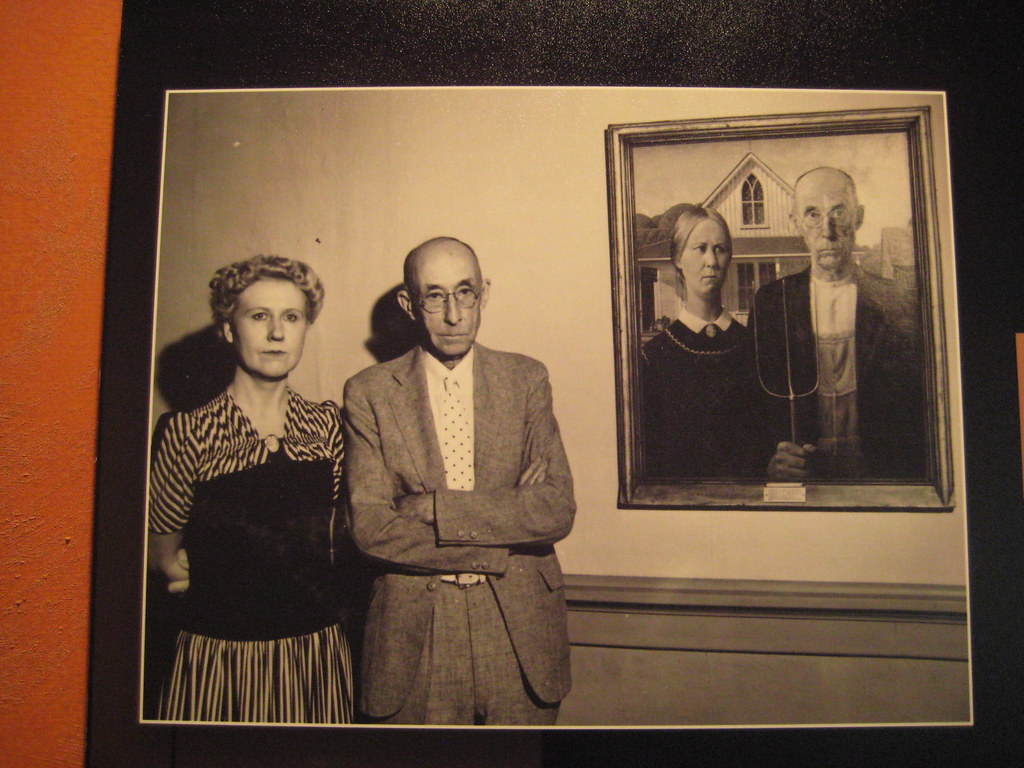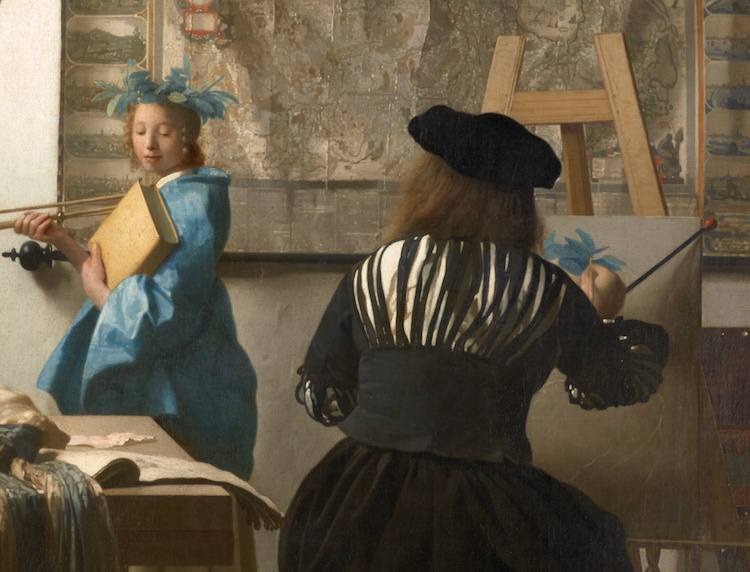
Johannes Vermeer, “The Art of Painting (Detail),” ca. 1666–1668 (Photo: Google Arts & Culture via Wikimedia Commons, Public domain)
This post may contain affiliate links. If you make a purchase, My Modern Met may earn an affiliate commission. Please read our disclosure for more info.
No matter the scope of their favorite subjects, most artists have dabbled in the age-old art of portraiture. Defined by portrayals of people, this genre has been practiced by art history’s most influential painters, culminating in an extensive collection of world-famous portraits.
While the artists behind these pieces are universally well-known, the subjects are often less obvious. Though many, including Gustav Klimt’s glimmering gold Portrait of Adele Bloch-Bauer, indicate the identity of the sitter, some are more vague, like the whimsical Woman with a Hat by Henri Matisse. In both cases, learning more about the paintings’ subjects can help us see these familiar and famous portraits in a new light.
Famous Paintings and the Real-Life People in Them
The Arnolfini Portrait, 1434
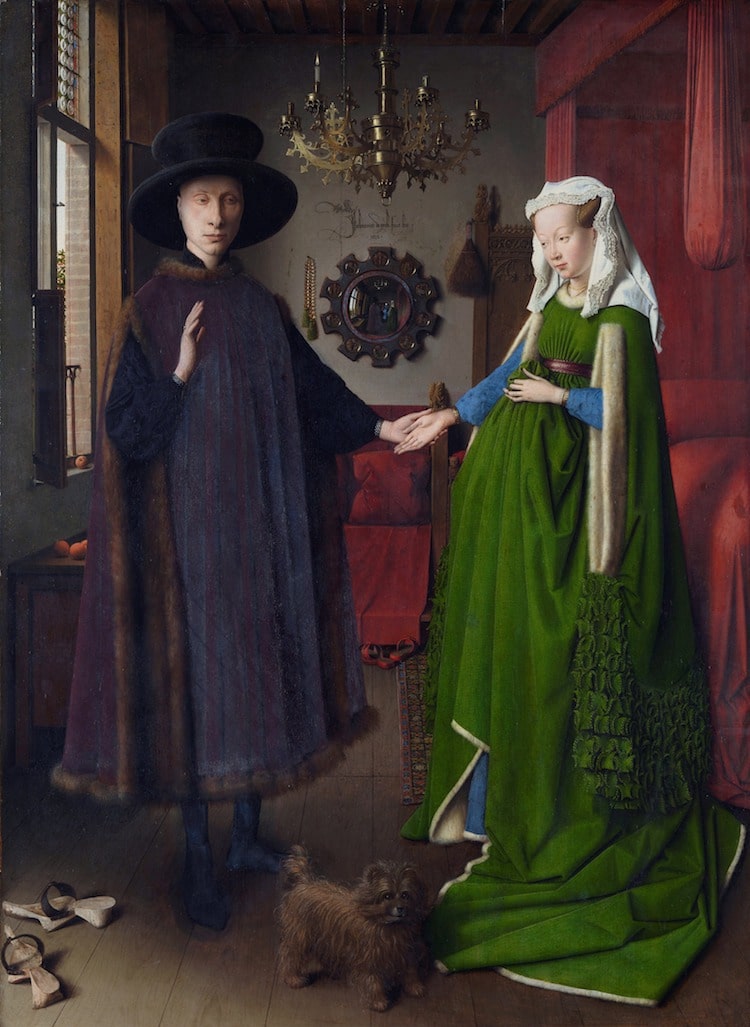
Jan Van Eyck, “Arnolfini Portrait,” 1434. (Photo: National Gallery via Wikimedia Commons, Public domain)
Born in what is now Belgium, artist Jan van Eyck was an early master of the oil medium and used it to create meticulously detailed compositions. His most prominent work, The Arnolfini Portrait, remains an icon of the Northern Renaissance—encapsulating many of the aesthetic ideals and technical innovations of the time period.
It depicts a wealthy merchant—presumed to be Giovanni di Nicolau di Arnolfini—and his wife in a lavishly decorated room which showcases their opulent wealth. The woman’s headdress suggests that they are indeed a married couple, as only unmarried women wore their hair down in 15th century Flanders. However, contrary to what many viewers think, the wife is not pregnant but is only holding her voluminous overdress at her chest, which was customary for the time.

Jan van Eyck, “Portrait of Giovanni Arnolfini,” c. 1434 (Photo via Wikimedia Commons, Public domain)
Mona Lisa, c. 1503–1516
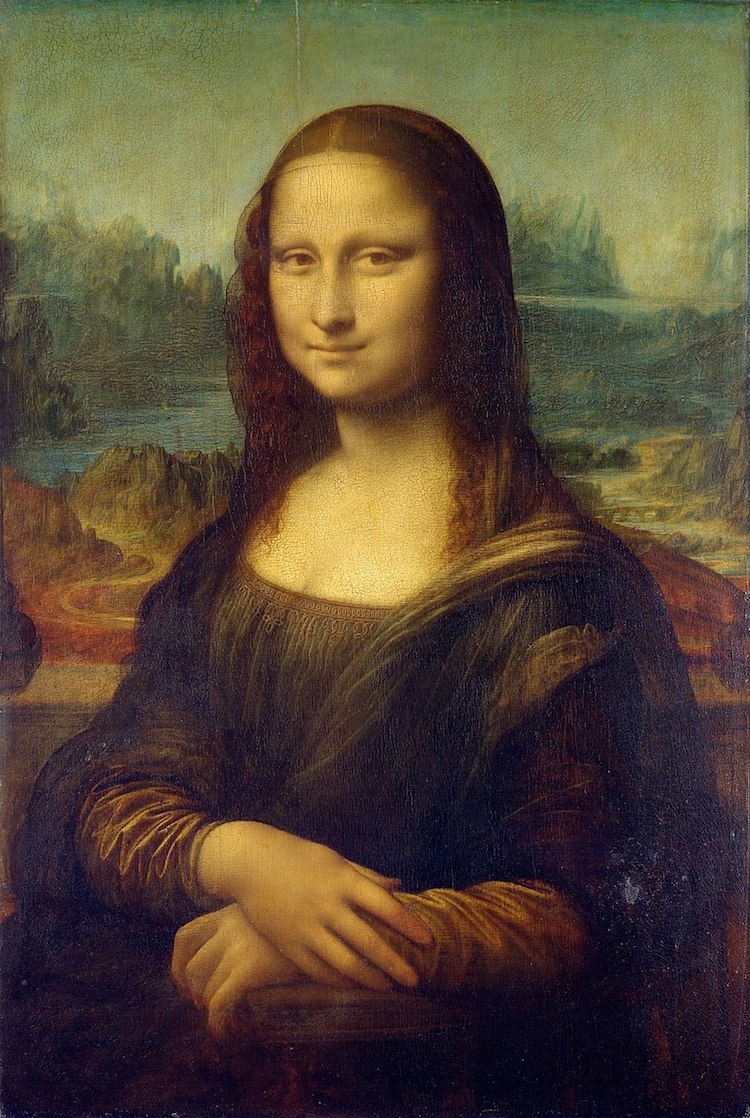
Leonardo da Vinci, “Mona Lisa,” c. 1503–1516 (Photo: Galerie de tableaux en très haute définition via Wikimedia Commons, Public domain)
Arguably art history’s most famous portrait, the Mona Lisa was painted by Italian artist, inventor, and writer Leonardo da Vinci in 1506. The masterpiece features a half-length portrait of a seated woman in a loggia (a room with at least one open side) that overlooks a hazy natural landscape. The figure looks toward the viewer and softly smiles.
So, who is the Mona Lisa? For centuries, the identity of the highly recognizable figure remained a mystery. However, in 2005, German scholars discovered a handwritten comment in the Heidelberg manuscript that positively identified her as Lisa del Giocondo (née Gherardini), a Florentine noblewoman. The portrait was commissioned by her husband, Francesco Giocondo, a merchant.
Though the portrait that hangs in Paris’ Louvre Museum is the most famous Mona Lisa, it’s not the only one. For centuries, many artists—including, in the case of the Prado Museum’s copy, Leonardo da Vinci’s pupils—have created their own portraits of the now-legendary Lisa del Giocondo.
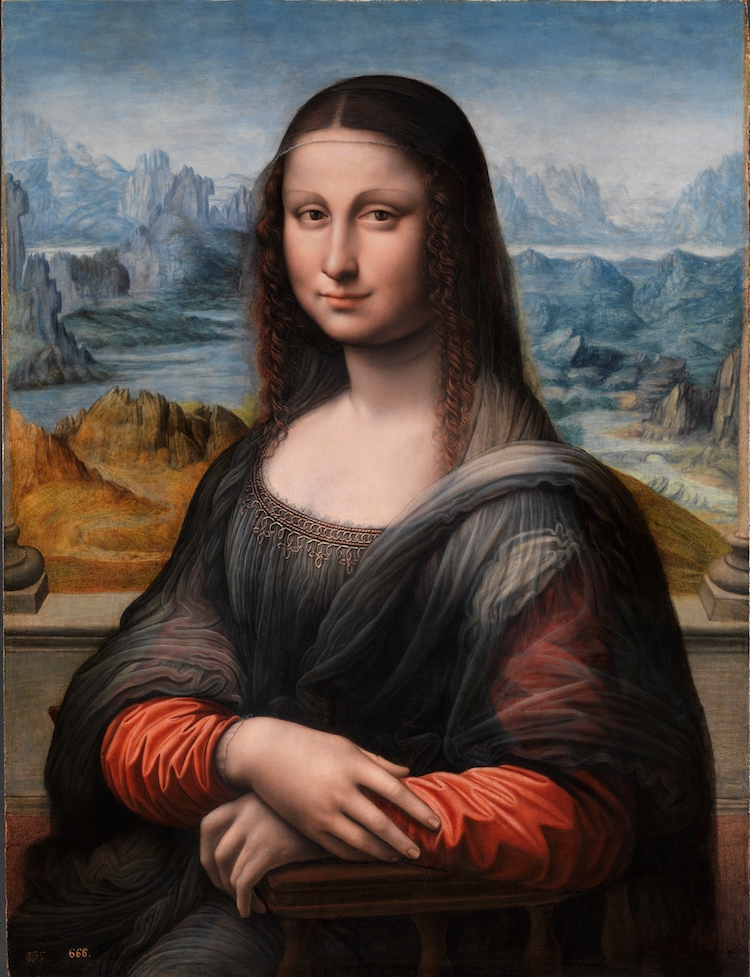
Workshop of Leonardo da Vinci, “Mona Lisa (Prado Copy),” ca. 1503-1516 (Photo: Museo del Prado via Wikimedia Commons Public Domain)
Girl with a Pearl Earring, c. 1665
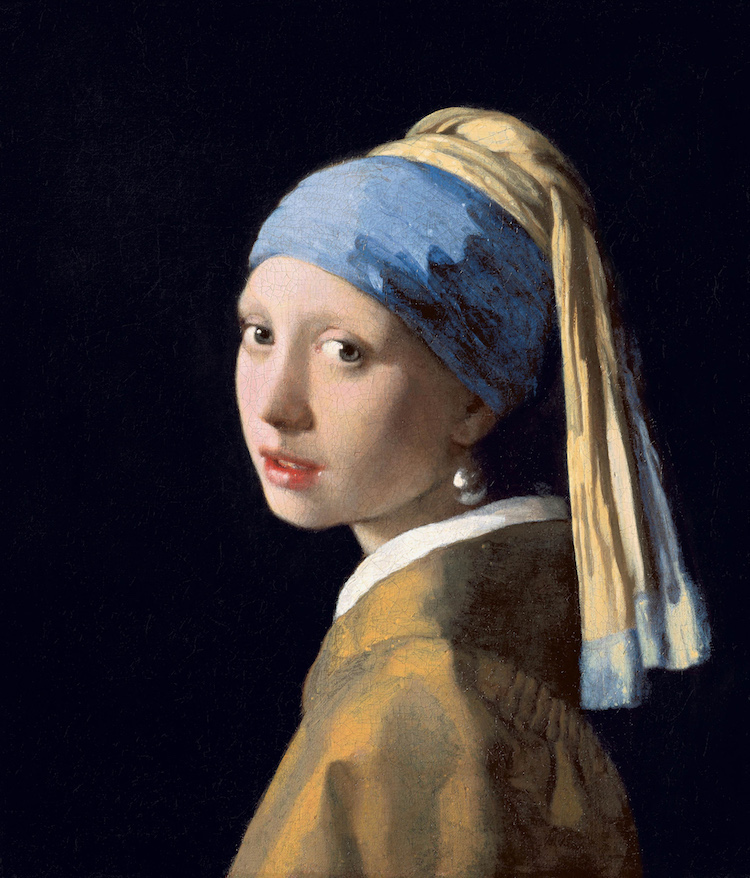
Johannes Vermeer, “Girl with a Pearl Earring,” c. 1665 (Photo: Mauritshuits via Wiki Art, Public domain)
In 1665, Dutch artist Johannes Vermeer created his most well-known work of art: Girl with a Pearl Earring. Several art historians have questioned the true identity of the young woman depicted in the painting. One of the most common theories is that the woman in question is Maria Vermeer, the painter’s eldest daughter. However, there are still several scholars who doubt this, and while this oil painting is often considered one of the most significant portraits, it’s not technically a portrait at all.
Girl with a Pearl Earring is actually a tronie—a study of an unidentified person. Tronies were particularly popular during the Dutch Golden Age, when artists like Vermeer and Rembrandt began adopting unnamed subjects for their “portraits.” Often, these figures are dressed in opulent clothing and set against a plain backdrop, which emphasized their anonymous nature.
Girl with a Pearl Earring is a prime example of this tradition, as it portrays an unknown girl dressed in lavish garments. “Like a vision emanating from the darkness, she belongs to no specific time or place,” art historians Arthur K. Wheelock and Ben Broos state in an exhibition catalogue. “Her exotic turban, wrapping her head in crystalline blue, is surmounted by a striking yellow fabric that falls dramatically behind her shoulder, lending an air of mystery to the image.”
Arrangement in Grey and Black, c. 1871
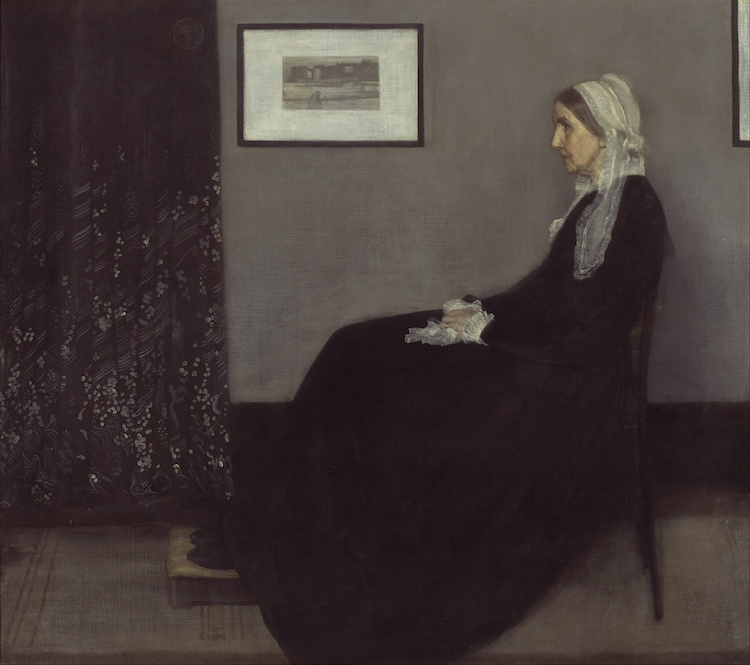
James Abbott McNeill Whistler, “Arrangement in Grey and Black No. 1,” 1871 (Photo: Musée d’Orsay via Wikimedia Commons, Public domain)
American artist James Abbott McNeill Whistler painted Arrangement in Grey and Black No. 1, a portrait of his mother, Anna McNeill Whistler, in 1871.
Born in North Carolina, Anna McNeill Whistler moved to Russia with her husband, George Washington Whistler, in the 1830s. Following his death several years later, she moved to England, where she lived with her son, James. It was in their London home that he painted this famous portrait, which shows the 67-year-old woman seated before a grey wall.
Though this piece is often referred to simply as Whistler’s Mother, the artist titled it Arrangement in Grey and Black No. 1 as a nod to his lyrical approach to painting. “As music is the poetry of sound, so is painting the poetry of sight, and the subject-matter has nothing to do with harmony of sound or of color. . . that is why I insist on calling my works arrangements and harmonies,” he said in 1878.
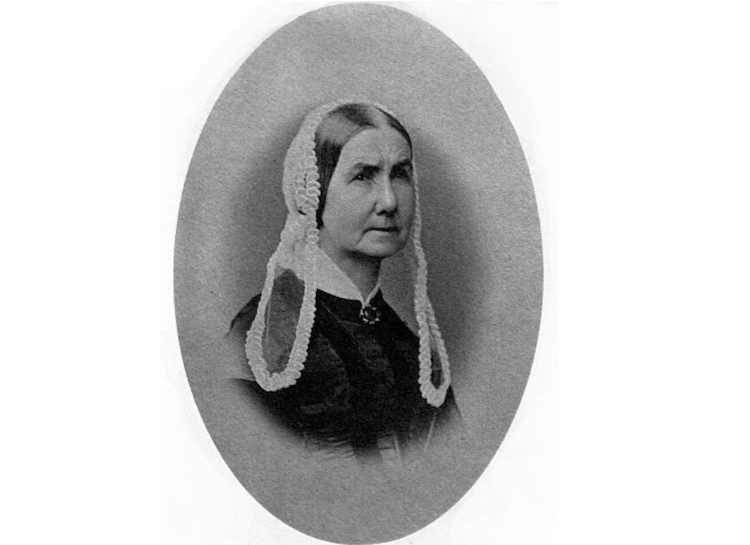
Anna Matilda Whistle (Photo via Wikimedia Commons, Public domain)
Madame X, 1884
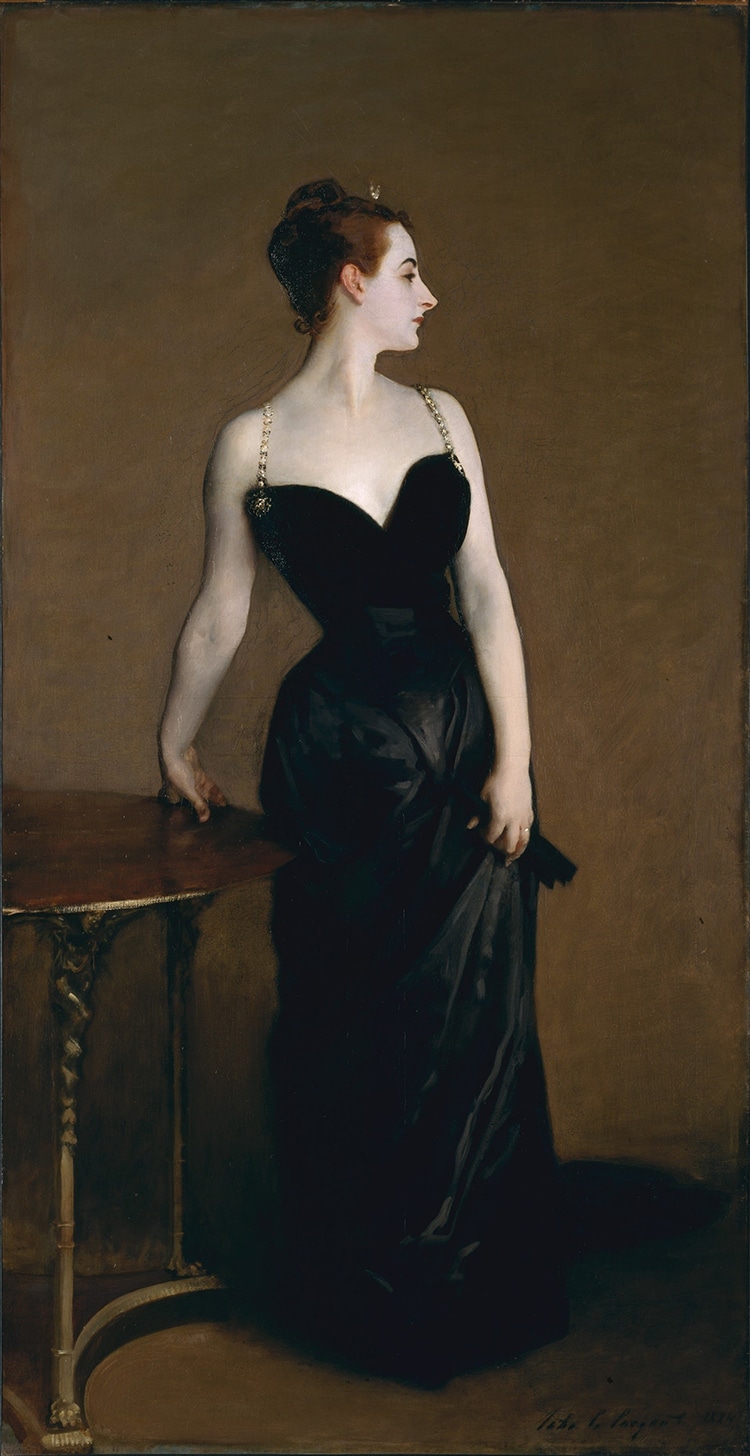
“Madame X (Madame Pierre Gautreau),” John Singer Sargent, 1884. Now at the Metropolitan Museum of Art. (Photo: Wikimedia Commons, Public domain)
American artist John Singer Sargent is best remembered for his portraits of the wealthy and aristocratic in England (where he resided after 1886) and America. Although inspired by the Grand Manner tradition of imposing, aristocratic portraits heavy on virtue symbolism, Sargent’s portraits were distinctly modern. Rather than neo-classical posturing or stylized stiffness, Sargent chose poses which suggested natural, effortless moments frozen in time.
His most famous portrait Madame X depicted the fashionable Madame Virginie Amélie Avegno Gautreau, an American socialite who married a French banker and resided in Paris. While Gautreau herself was pleased with the image, it caused controversy when it was displayed at the Salon in Paris in 1884 due to the provocative clothing and relaxed pose.
Sargent and the Salon tried to keep the identity of Gautreau a secret, but ultimately it became common knowledge and both the artist and the sitter were left discomfited by the painting. Sargent left Paris for London shortly afterward.
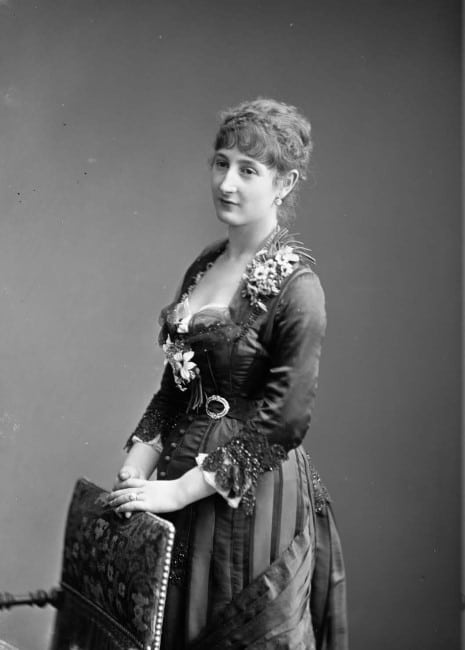
Photograph of Virginie Amélie Avegno Gautreau, c. 1878 (Photo via Wikimedia Commons, Public domain)
Woman with a Hat, 1905

Henri Matisse, “Woman with a Hat,” 1905 (Photo: SFMOMA via Wikimedia Commons, Public domain)
In 1905, artist Henri Matisse painted Woman with a Hat, a polychromatic portrait of his wife, Amélie. In addition to showcasing Matisse’s expressive approach to painting and shaping Fauvism, this painting playfully points out Amélie’s real-life profession: owning a hat shop.
While Amélie worked as her husband’s manager for many years, his obsession with his craft eventually drove them apart. “I love you dearly, mademoiselle,” Matisse famously told his wife, “but I shall always love painting more.”
Though they separated in 1939 after over 40 years of marriage, both their romantic and working relationships are immortalized by Woman with a Hat and several other paintings featuring Madame Matisse.
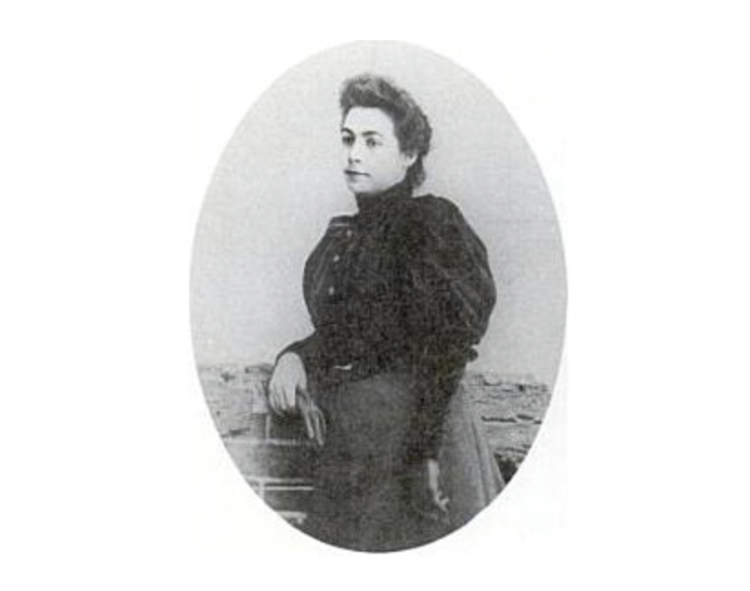
Amélie Matisse (Photo via Wikimedia Commons, Public domain)
Portrait of Gertrude Stein, 1905–6
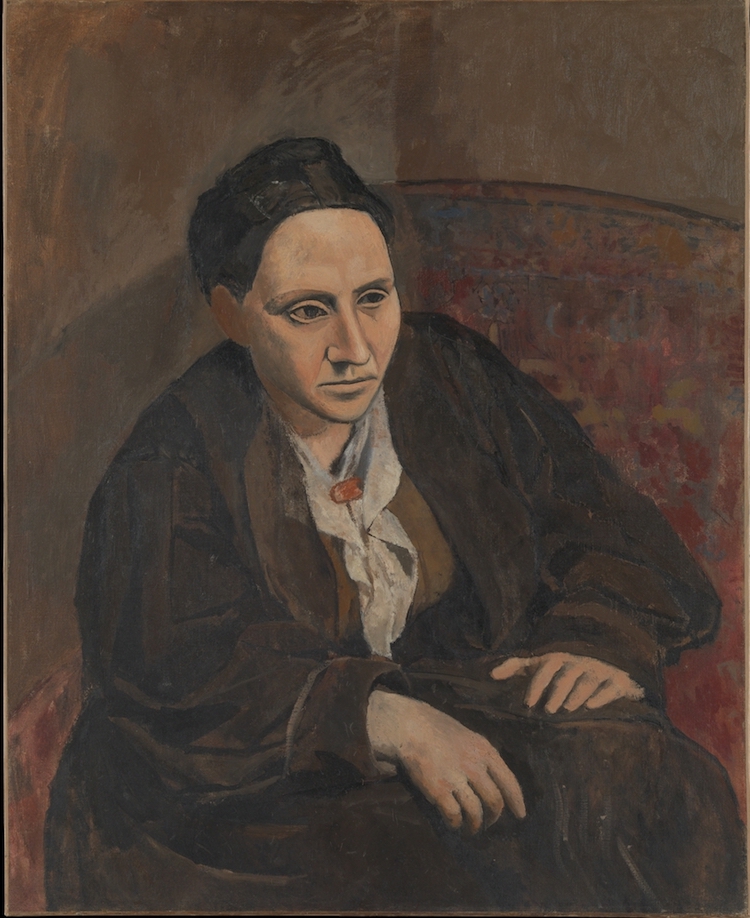
Pablo Picasso, “Portrait of Gertrude Stein,” 1905–1906 (Photo via Wikimedia Commons, Public domain)
In the early 20th century, acclaimed writer and art collector Gertrude Stein was at the forefront of Paris’ avant-garde. After moving from Oakland, California to the French capital in 1903, she worked closely with important modernist figures, from groundbreaking writers like F. Scott Fitzgerald and Ernest Hemingway to avant-garde artists like Henri Matisse and Pablo Picasso.
Stein’s support was particularly important to Picasso, who credited her patronage as a catalyst for his early success. In 1905, he painted a portrait of Stein in a style typical of his Rose Period, a phase characterized by a warm color palette and hints of “primitive” influences, such as African masks and Iberian sculpture.
On top of illustrating the key features of this important period, Portrait of Gertrude Stein also captures his sitter’s self-assured demeanor and self-made status—much to Stein’s satisfaction. “I was and I still am satisfied with my portrait, for me, it is I, and it is the only reproduction of me which is always I, for me,” she wrote in her book, Picasso.
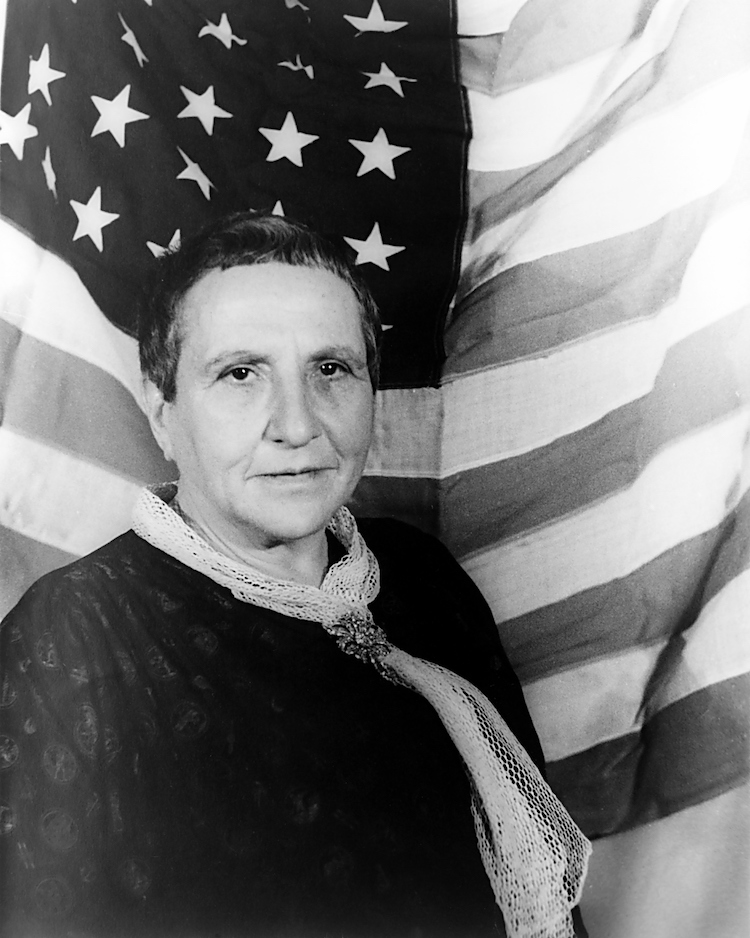
Carl Van Vetchen, “Portrait of Gertrude Stein, with American Flag as Backdrop,” 1935 (Photo: Library of Congress via Wikimedia Commons, Public domain)
Portrait of Adele Bloch-Bauer, 1907
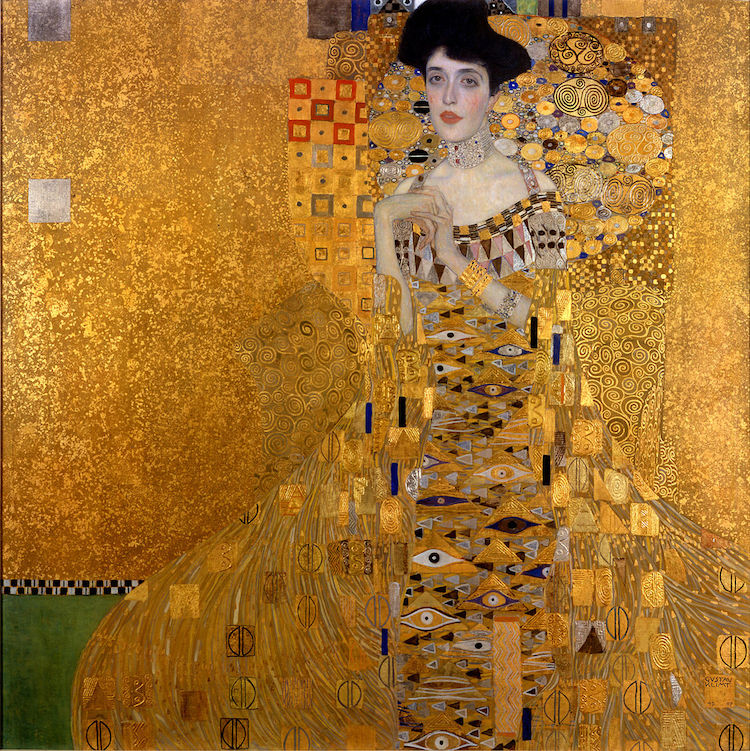
Gustav Klimt, “Adele Bloch-Bauer I,” 1907 (Photo: Neue Galerie via Wikimedia Commons, Public domain)
During his Golden Period, artist Gustav Klimt began embellishing his canvases with gold leaf. This monumental decision culminated in two of his most treasured paintings: The Kiss and Portrait of Adele Bloch-Bauer I.
Portrait of Adele Bloch-Bauer I stars Adele Bloch-Bauer, a wealthy Jewish woman from Vienna. Believed to be either a friend or mistress of the artist, Bloch-Bauer was a patron of the arts. She and her husband, Ferdinand Bloch-Bauer, amassed a collection of over 400 works of art, including Portrait of Adele Bloch-Bauer—a painting commissioned by Ferdinand as an anniversary present for his in-laws.
In addition to its ethereal depiction of Mrs. Bloch-Bauer, the painting is famous for its controversial history. While she declared in her will that the painting should go to the Austrian State Gallery in Vienna, her brother-in-law considered this a “request” and decided to keep it in the family. It was often loaned to museums and galleries for exhibitions, but was stolen by the Nazis in 1941.
After the war, it was placed in Vienna’s Österreichische Galerie Belvedere, where it remained until it was returned to the Bloch-Bauer family in 2006. Months later, they sold it for $135 million.
American Gothic, 1930
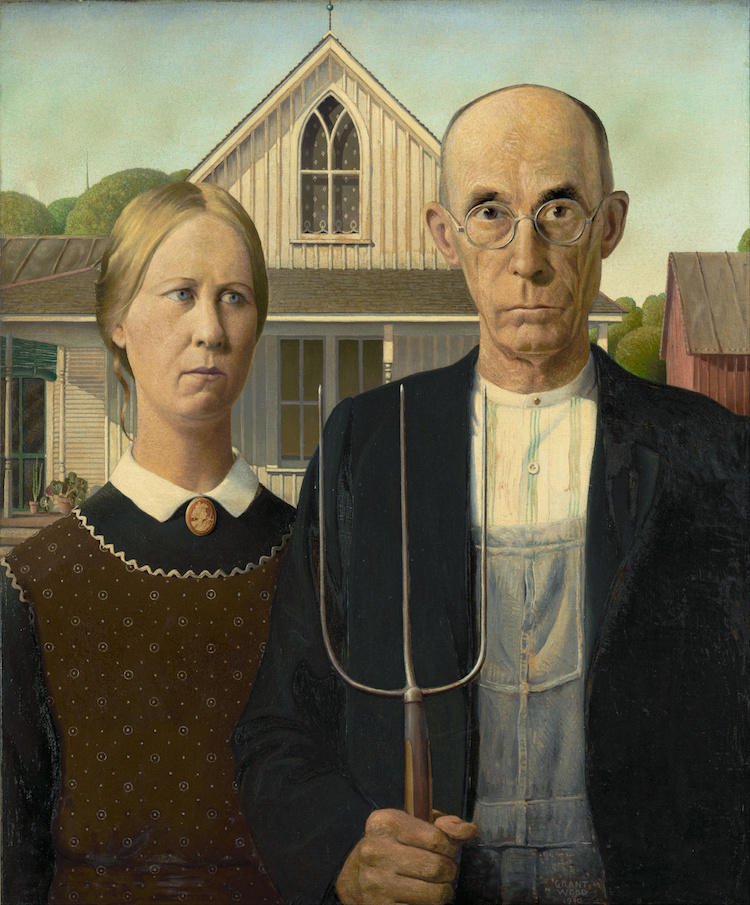
Grant Wood, “American Gothic,” 1930 (Photo: Google Arts & Culture via Wikimedia Commons, Public domain)
Artist Grant Wood painted American Gothic, one of the most famous modern American paintings, in 1930. While many people assume that the somber-looking man and woman are based on a real-life farmer and his wife, the iconic painting is actually a portrait of a unlikely duo: the artist’s younger sister, Nan Wood Graham, and dentist, Dr. Byron McKeeby.
Wood was inspired to create this painting when he saw the Dibble House, a “very paintable” Neo-Gothic home in Eldon, Iowa. To set the scene, he opted to include “the kind of people [he] fancied should live in that house.” Rather than seek out sitters for the painting, he asked Graham and McKeeby to model.
While Wood intended the pair to represent a father and his daughter, he was open to viewers’ interpretations. “These particulars, of course, don’t really matter,” the artist wrote in a letter in 1941. “What does matter is whether or not these faces are true to American life and reveal something about it.”
This article has been edited and updated.
Related Articles:
Iconic Artists Who Have Immortalized Themselves Through Famous Self-Portraits
20 Art History Terms to Help You Skillfully Describe a Work of Art
Fascinating Paintings Reveal the Unique Studios of 5 Famous Artists
Monumental Masterpieces: 8 of Art History’s Most Famous Large-Scale Paintings


